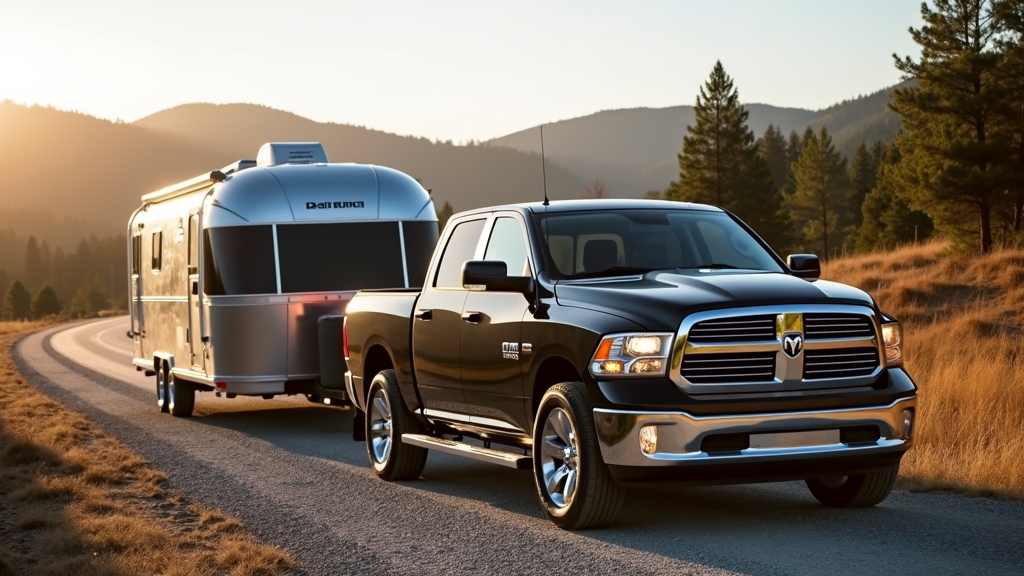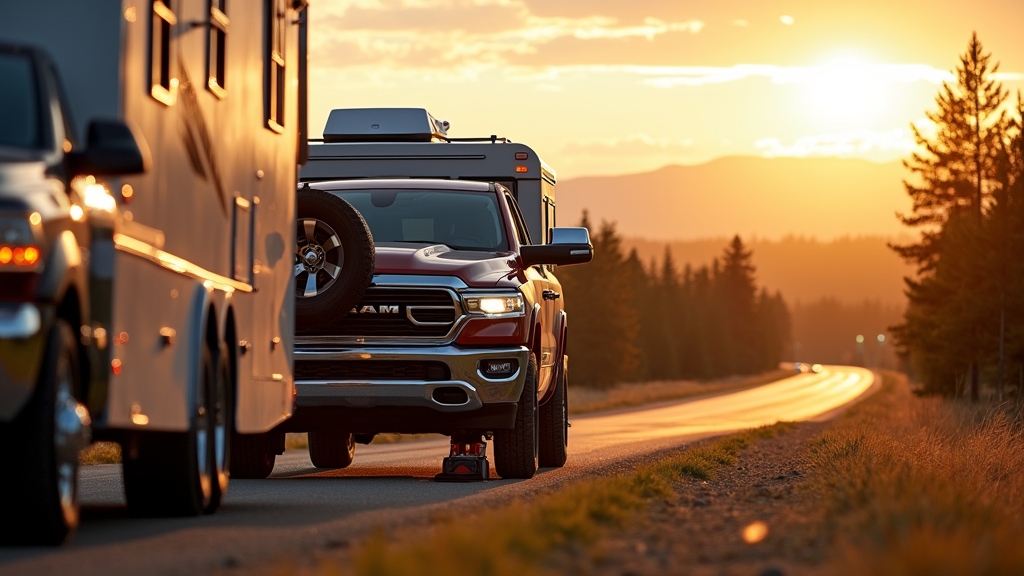You can tow a 30-foot camper with a Ram 1500 if you choose the right engine, like the 5.7L HEMI V8 with higher towing limits. Ensure the camper’s weight stays within your truck’s towing and payload ratings.
Keep in mind, heavier campers require proper axle ratios, balanced loads, and safety gear like weight-distributing hitches for stability. Managing these factors helps you tow safely and confidently.
To fully understand what’s involved, keep exploring the details.
Key Takeaways
- A Ram 1500 with a 5.7L HEMI V8 can tow up to 12,750 lbs, suitable for most 30-foot campers under fully loaded weights.
- Fully loaded 30-foot campers often weigh 6,500 to over 10,000 lbs, requiring careful matching to the Ram 1500’s towing capacity.
- Higher axle ratios (e.g., 3.92) improve towing ability and acceleration for heavy campers but reduce fuel efficiency.
- Payload limits (1,520–2,370 lbs) and tongue weight must be managed to ensure safe towing and proper vehicle handling.
- For heavier or fully loaded campers, upgrading to a Ram 2500 or using weight-distributing hitches enhances safety and stability.
Understanding Ram 1500 Towing Capacities

While the Ram 1500 offers impressive towing capabilities for a half-ton pickup, you should carefully consider its specific engine and configuration to guarantee it suits your camper’s weight. For extended trips where power needs arise, using a generator for charging RV batteries can help maintain your camper’s electrical systems without draining your truck’s resources.
The 2025 Ram 1500’s maximum towing ranges from 8,110 lbs with the 3.6L Pentastar V6 eTorque up to about 11,580 lbs with the 3.0L Hurricane twin-turbo I6. Additionally, certain trims feature advanced trailer management systems, including trailer reverse steering control, to make maneuvering easier when towing.
Payload varies between 1,520 and 2,370 lbs depending on the setup. Most 30-foot campers weigh between 6,000 and 8,500 lbs dry, with GVWR often reaching 7,500 to over 10,000 lbs once fully loaded.
Engine Options and Their Impact on Towing
Considering the engine you choose for your Ram 1500 substantially influences its towing performance, especially when hauling a 30-foot camper. Selecting the right brake pads is also crucial to ensure safe and effective stopping power under heavy loads, particularly when towing.
The 5.7L HEMI V8 offers the highest towing capacity, up to 12,750 pounds, balancing 410 lb-ft torque for steady pulls. This engine is known as the strongest Ram 1500 engine ever, providing exceptional power for demanding towing needs.
The 3.0L Hurricane twin-turbo I6 provides 11,550 pounds towing with improved fuel efficiency, while the high-output version delivers 540 HP and 521 lb-ft torque but lowers payload capacity.
The 3.6L Pentastar V6, towing up to 8,110 pounds, suits lighter campers and favors fuel economy. Proper heat dissipation in braking components becomes more critical with lighter engines to maintain consistent braking performance.
Higher torque helps with initial acceleration and climbing, vital for heavy trailers.
Your engine choice impacts not just towing capacity but fuel consumption and payload, so selecting the right powertrain aligns with your camper’s weight and intended driving conditions.
Weight Considerations for 30 Foot Campers

How much does a 30-foot camper weigh, and why does it matter for towing? A typical 30-foot camper weighs between 4,300 and 5,800 pounds dry.
However, fully loaded with water, passengers, and cargo, it can easily reach or exceed 6,500 pounds. This weight is vital because your towing vehicle must handle not only the camper’s weight but also its Gross Vehicle Weight Rating (GVWR), which sometimes surpasses 7,000 pounds.
Choosing the right battery system, such as AGM batteries, can help manage electrical loads efficiently during travel. You need a vehicle with adequate towing capacity, generally more than 6,500 pounds, to tow safely. Proper weight distribution is essential too, as uneven loads affect stability.
Managing cargo, fluids, and features ensures your Ram 1500 can tow the camper efficiently without compromising safety or performance. Since water weighs 8.3 lbs per gallon, the amount of water carried can significantly impact the camper’s total weight and towing requirements.
Effects of Axle Ratios on Towing Performance
So, the axle ratio is pretty important, right? It essentially tells you how many times the drive shaft spins for each rotation of the wheels. This has a direct impact on your towing capability. Choosing the right axle ratio can also affect your vehicle’s fuel efficiency during long trips.
If you have a higher axle ratio, you’re going to get more torque and better acceleration. This can be a game-changer when you’re hauling something heavy, like a 30-foot camper, for example. The 2025 RAM 1500, for instance, offers impressive towing capacities up to 11,570 lbs towing, which is influenced by its drivetrain setup including axle ratios.
On the flip side, if you opt for a lower axle ratio, you might see some improvements in fuel efficiency. But here’s the catch: you’ll sacrifice some low-speed power, which can definitely affect how well you tow.
Axle Ratio Basics
When you adjust the axle ratio on a Ram 1500, you directly impact its towing performance by changing the torque delivered to the wheels. Using the correct axle ratio also helps maintain optimal engine temperature by ensuring efficient cooling system performance with the right antifreeze formulation.
A higher axle ratio, like moving from 3.21 to 3.92, increases towing capacity by roughly 2,000 to 3,000 pounds. This provides more torque for heavy loads.
However, this also raises engine load, which can reduce fuel efficiency and increase wear on engine and transmission components if not maintained properly. Different axle ratios often require compatible tire sizes, influencing towing stability and vehicle handling.
While upgrading can improve towing capability, it involves costs and typically professional installation. Upgrading to a 3.92 ratio often involves replacing both axles, especially in 4×4 models, which adds complexity and expense to the process axle replacement.
Choosing the right axle ratio involves balancing increased towing capacity against fuel economy and maintenance considerations. This ensures your Ram 1500 performs safely and efficiently when pulling a 30-foot camper.
Impact on Acceleration
It directly affects torque delivery to the wheels, which is vital when moving heavy loads like a 30-foot camper. A higher axle ratio, such as 3.92, provides more torque, helping your truck accelerate more efficiently, especially on inclines or challenging terrain. Choosing components with the proper torque delivery characteristics can enhance towing performance significantly.
This means your Ram 1500 can handle the initial push better, reducing strain on the engine and transmission. Additionally, the towing capacity depends significantly on the engine choice, which in combination with the axle ratio, determines the maximum towing capacity the truck can safely manage.
However, higher ratios may decrease fuel efficiency during normal driving. Conversely, lower ratios like 3.21 improve highway fuel economy but can compromise acceleration and towing power.
When towing a heavy camper, choosing the right axle ratio balances power and efficiency, ensuring your Ram 1500 performs at its best without sacrificing fuel economy or handling.
Handling and Stability With Longer Trailers
When you’re out on the road towing a 30-foot camper with your Ram 1500, it’s super important to keep control of that trailer sway. Seriously, it can really make a difference in how stable you feel while driving.
You might find that longer trailers can throw off your maneuverability, especially when you hit sharp turns or if the wind picks up. Using wheel bearing grease designed for heavy loads can help maintain smooth and safe towing performance. It’s also essential to consider that the Ram 1500’s limited payload capacity can affect overall towing stability.
But don’t worry too much! There are ways to tackle these challenges head-on. For starters, consider installing sway control devices. They can work wonders in keeping everything steady. Plus, tweaking your driving technique can also make a big impact. Just take it slow and steady, and you’ll handle those twists and turns like a pro!
Trailer Sway Control
Although towing a 30-foot camper with a Ram 1500 can be manageable, maintaining stability requires effective trailer sway control systems. These systems detect trailer oscillations and counteract them by applying selective braking and reducing engine power, working within the truck’s electronic stability control.
Longer trailers pose greater sway challenges due to increased leverage and exposure to crosswinds, demanding more responsive sway control. Using an anti-sway trailer hitch can significantly reduce these lateral movements and improve overall control.
Proper tongue weight balance (10–15% of loaded weight), load distribution, and well-maintained brakes and tires are critical for ideal sway control performance. It is important to remember that the Ram 1500’s payload rating includes the trailer tongue weight along with occupants and cargo, so these factors must be accounted for to avoid overloading.
You can enhance stability further with weight distribution hitches, aftermarket sway control devices, or anti-sway bars.
Engaging these systems properly helps you maintain control and confidence, particularly at highway speeds, ensuring safer towing of larger campers with your Ram 1500.
Impact on Maneuverability
Handling a 30-foot camper with a Ram 1500 demands careful attention to maneuverability, as the increased trailer length considerably affects stability and control.
Longer trailers amplify tail swing during turns, requiring you to make wider arcs to avoid obstacles. Using a battery monitor can help ensure your RV’s power systems remain reliable during extended trips.
The Ram 1500’s shorter wheelbase lessens stability, making the truck more susceptible to trailer sway and lateral wind forces. Wind gusts can cause instability, especially at higher speeds, so monitoring weather conditions is crucial.
You’ll notice reduced precision in lane changes and merges due to response lag. Parking and tight maneuvers become challenging, demanding greater skill and caution.
Additionally, the concentrated weight behind the rear axle affects payload distribution, which can compromise steering and braking. To maintain safe handling, you should leave a safety margin below max towing capacity and avoid sudden steering or braking inputs.
Real-World Experiences Towing Large Campers
Towing a 30-foot camper with a Ram 1500 presents practical challenges that go beyond just matching numbers on a spec sheet. Real-world experiences highlight that the length and weight of such campers can strain the Ram 1500, especially during extended trips. It is also important to consider stability features when towing larger loads to enhance safety.
While the truck can tow up to 10,600 pounds when properly equipped, payload limitations and the Gross Combined Weight Rating (GCWR) must be carefully considered. Different axle ratios, such as 3.92 gears, can provide better towing capacity and performance for heavier loads.
Many users find that fifth-wheel campers increase the load on the truck’s rear axle, affecting stability. Weight-distributing systems are commonly recommended for trailers over 5,000 pounds to maintain control.
Some drivers opt for smaller campers or upgrade to a Ram 2500 to better manage payload and towing demands, ensuring safer and more reliable performance on the road.
Recommended Equipment for Safe Towing
Managing a 30-foot camper safely with your Ram 1500 requires more than just knowing your truck’s towing capacity; it demands the right equipment to handle the load effectively.
Start with a weight-distributing hitch featuring sway control to stabilize the trailer. A trailer brake controller is essential for safe stopping, complemented by a heavy-duty Class IV receiver hitch and properly sized hitch ball.
Upgrading your rear suspension with airbags or helper springs enhances stability under heavy tongue weight. Opt for the maximum towing package, including a transmission cooler and integrated wiring harness. Using a weight distribution system such as the BMW Continuum hitch with hydraulic adjustment can significantly improve stability and handling.
Don’t forget safety chains crossed under the tongue and wide-angle towing mirrors for visibility. Regularly inspect tires, brakes, and lights, and use tire chocks during setup. These measures ensure your Ram 1500 handles a large camper securely and reliably.
Speed and Driving Tips When Towing a 30 Foot Camper
Because pulling a 30-foot camper markedly changes your vehicle’s dynamics, you’ll want to modify your speed and driving habits accordingly. Keep your speed lower than usual to improve stability and control, especially considering added wind resistance and the camper’s weight.
Accelerate and brake gradually to handle the increased mass safely and avoid trailer sway. Steer clear of sudden lane changes, which risk loss of control.
When driving on hills, manage speed carefully; use lower gears going downhill to prevent brake overheating and maintain control. Always adjust your speed based on road and weather conditions, such as rain or uneven surfaces, to ensure traction and stability.
Regularly monitor your truck and trailer’s condition, including tire pressure and brakes, to maintain safe towing performance. Using a weight distribution hitch can help improve handling and stability when towing large campers like a 30-foot trailer.
When to Consider Upgrading to a Larger Truck?
If you frequently encounter handling difficulties or notice your Ram 1500 operating near its maximum towing limits, it may be time to contemplate upgrading to a larger truck. Manufacturers publish towing capacities assuming only the driver onboard, so additional cargo and passengers can affect safe limits.
Signs include persistent trailer sway, engine or brake overheating, and consistently using tow/haul mode to maintain control. When your camper’s GVWR approaches 80% of your truck’s max tow rating or tongue weight nears payload capacity, safety margins shrink, stressing drivetrain and suspension.
Frequent near-max payload loading with passengers and gear also signals limits. Upgrading to a ¾- or 1-ton truck like the Ram 2500 or 3500 offers higher payloads, improved GCWR, and greater towing capacity, enhancing stability, control, and durability.
This ensures safer, more comfortable towing, especially with heavy or high-profile 30-foot campers. Always consider the Gross Combined Weight Rating when evaluating towing capabilities to maintain safety margins.
Frequently Asked Questions
How Does Weather Affect Towing a 30-Foot Camper With a Ram 1500?
Weather affects your towing by reducing tire traction in rain or snow, increasing stopping distances and risk of sway in wind. Cold thickens fluids, limiting initial power, while heat can cause overheating and tire pressure loss.
Fog lowers visibility, demanding cautious driving. Your Ram 1500’s stability controls help but aren’t foolproof in icy or uneven conditions. You’ll need to slow down, increase following distance, and perform thorough pre-trip checks to tow safely.
What Are the Insurance Implications of Towing a Large Camper?
Towing a large camper is like balancing on a tightrope. Your insurance coverage must be thorough.
You’ll likely need higher liability limits and specialized trailer insurance. Make sure your policy includes extensive coverage for the camper and proof of proper towing equipment.
Exceeding weight limits or improper setup can void claims. Also, expect increased premiums and stricter underwriting.
Always check state laws for required coverage to avoid fines or denied claims.
Can a Ram 1500 Handle Off-Road Towing With a 30-Foot Camper?
You can handle off-road towing a 30-foot camper with a Ram 1500, but it’s near the upper limit.
You’ll want a properly equipped model, preferably with a 3.92 axle ratio and air suspension, to manage payload and stability.
Keep camper weight well within towing ratings, use weight distribution hitches, and drive cautiously on rough terrain.
For frequent or heavy off-road towing, consider a heavier-duty truck for better safety and durability.
How Often Should Towing Equipment Be Inspected or Replaced?
Think of your towing gear like the heartbeat of a safe trip. It needs regular checks. You should inspect towing equipment before every trip and at least monthly if you tow often.
Always check after harsh weather exposure. Replace parts showing cracks, rust, or wear immediately. Follow manufacturer guidelines for inspections and replacements. Annual professional checks catch hidden issues.
Staying on top of this keeps you safe and your gear reliable.
Are There Legal Restrictions on Towing Camper Length With a Half-Ton Truck?
You won’t find federal laws restricting camper length when towing with a half-ton truck like the Ram 1500.
However, some states and local jurisdictions might have specific rules, so you should verify those before hitting the road.
Also, insurance policies can impose their own limits.
To stay safe and legal, always follow manufacturer guidelines and local regulations.
This way, you’ll avoid fines and ensure a smooth towing experience.
Know Your RAM 1500’s True Towing Potential
If you’re planning to tow a 30-foot camper with your RAM 1500, knowing your truck’s limits is key. With the right engine, axle ratio, and towing equipment, it can handle the job, but it’s no walk in the park.
Think of towing as a delicate dance between power and control; pushing beyond its capacity can lead to trouble. Stay informed, drive carefully, and upgrade if your camper’s weight tips the scales too far.



